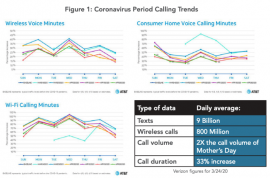Boost in voice calls poses opportunities for marketers using call analytics platforms

While many expected the work-from-home revolution sparked by COVID-19 to result in higher- than-usual traffic on the internet, what has come as something of a surprise is the dramatic increase in the volume of voice calls. In late March, Verizon reported that its network was seeing more than double the number of phone calls each day (800 million wireless calls) as it sees on a typical Mother’s Day – its highest Sunday of the year for call volume.
“For years, we’ve seen a steady decline in the amount of time people spend talking to one another, especially on wireless devices,” Kyle Malady, Verizon’s CTO, said in a recent New York Times article. “The move to staying home has reignited people’s hunger to stay connected, voice-to-voice.”
AT&T has seen the same trend, with voice calls up significantly over pre-COVID-19 levels, whether they’re occurring on mobile phones, landlines or using Wi-Fi calling.
“Voice is the new killer app,” Chris Sambar, AT&Ts EVP of technology and operations told the New York Times. “It’s been a real surprise.”
As businesses begin re-opening in stages, consumers are likely to interact with them via phone as they seek information about products and services while at a safe social distance, and as they coordinate for curbside pick-ups from local retailers and restaurants. Though the popularity of voice calls is likely to return to nearer pre-COVID-19 levels over time, the “new normal” may involve more phone call interactions between consumers and businesses than occurred before the pandemic hit.
More about Call Analytics
- Download our buyer’s guide to call analytics platforms now!
- Call Analytics tools in the spotlight: Marketing’s unsung heroes
- Are you effectively monetizing, measuring and maximizing your inbound call volume?
- Pick up the phone, Neo. Why Call Analytics Is One of the Most Underrated Marketing Strategies.
Pre-Coronavirus call trends
Even before consumers’ interactions with businesses were changed by the advent of the novel coronavirus, they had made mobile calls an integral part of their purchase journeys – because they sought more immediate gratification of their business information wants and needs. BIA Advisory Services predicted that more than 170 billion inbound mobile calls will be made to U.S. businesses in 2020.
Meanwhile, BrightLocal research found that 60 percent of U.S. consumers prefer to contact a business by phone after finding them online – compared to just 16 percent who prefer email and 15 percent who prefer to visit the business location.
Phone calls provide deep-in-the-funnel prospects with fast answers, connections to real people and the type of detailed information that can play an important role in high-consideration purchases. For marketers, inbound callers are proving to be highly engaged with brands, and they convert more quickly than consumers that do not use the phone to interact with businesses.
According to Pick up the Phone: Your Best Customer Is On the Line, published by Forrester Consulting, the majority of marketers using ads that prompt consumers to initiate a phone call say those consumers:
- Have a 28 percent higher retention rate.
- Convert an average of 30 percent faster.
- Spend an average of 28 percent more.

As a result, most digital marketers are stepping up their use of inbound calls as a marketing channel. Forrester found that 94 percent of marketers surveyed are either using, piloting or planning to use inbound calls as a customer marketing channel – third only behind email and mobile websites, tied with social media and ahead of display, search and desktop websites.
If you’re implementing call analytics as part of your martech stack, or are considering switching to a different provider, we encourage you to check out our MIR for everything you need to know!
The post Boost in voice calls poses opportunities for marketers using call analytics platforms appeared first on Marketing Land.
From our sponsors: Boost in voice calls poses opportunities for marketers using call analytics platforms




